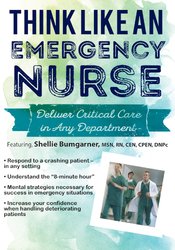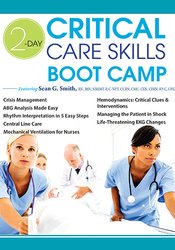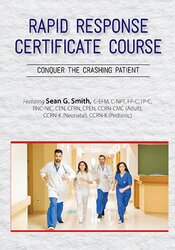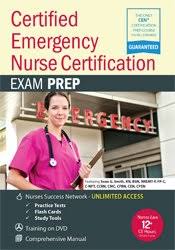What You’ll Discover in Sean G. Smith Think Like an Emergency Nurse Deliver Critical Care in Any Department
- Faculty:
- Sean G. Smith
- Duration:
- 6 Hours 14 Minutes
- Format:
- Audio and Video
- Copyright:
- Oct 19, 2017.
Description
- Respond to a crashing patient – in Any setting
- Understanding the “8-minute hour”
- Mental strategies are essential for success in Emergencies
- Improve your confidence in handling patients who are deteriorating
Your coworker calls for help – you go in I was able to see her patient sitting up and speaking just a few seconds ago. Now she is turning blue and gasping desperately for air. You have a real chance to intervene and make a difference – that’s why you became a nurse! What are your plans?
Imagine you are taking care of your patient – anywhere – the office, clinic, Nursing Home, OR, in The community and suddenly grasp that an An emergency situation is developing. Are you unsure what to do? What should you do? Even if they call an You may be able to take care of the patient for as long as 8 minutes if you have an ambulance or a rapid response team. What can you do? in You can increase your chances for a positive outcome by taking the time now.
How can you save lives?
The patient is down the hall and needs your help. As soon as you walk into the room, you notice him start to vomit. He becomes pale, and less responsive – but still awake. You call Rapid Response, and you stay with him until the team arrives. They take care of the patient.
You’re left wishing you had done more – he was your patient, after all.
This intensive course will give you the clinical insight and critical thinking skills that ED nurses need to be successful.. No longer will you feel scared or uncertain.
Exciting clinical cases will help to strengthen your ability as a clinician to evaluate, intervene, and advocate. You will be amazed at the changes that occur. in Your own practice, when you are working your next shift!
Handouts
| Manual Think Like an Emergency Nurse (4 MB) | 51 Pages | Available after Purchase |
Outline
What can you do to improve patient outcomes?
- How to prevent it from happening
- Confidence – Increase your confidence in Emergent situations
- Every patient encounter should be considered a disaster.
- Advocate for your patient
- Communicating high-risk information clearly
- Mental strategies to success
- Cognitive pre-Planned
- How preparation for success is related to the fire service
Risk Reduction
- Recognizing risk for clinical decline
- How to intervene before an Event
- Why is your respiratory rate important?
- Plan to capitalize on your strengths and develop a strategy for dealing with your weaknesses
- Assemble your team
Common Emergency Conditions
- You can save lives by taking these steps
- These are the 3 most important interventions for each individual.
- Common Emergency Conditions
- Cardiac Arrest
- Choking/Dislodged the tracheostomy
- Major Trauma
- Hemorrhage can be controlled
- Sepsis
- GI Bleed
- Neurology
- CVA/TIA: Acute Ischemic & Hemorrhagic
- Seizure
- Subarachnoid bleed
- Intracranial hypertension
- Is 170/90 blood pressure really dangerous?
- Cardiology
- Dysrhythmias
- Ventricular fibrillation
- Ventricular tachycardia or Asystole
- SVT
- Rapid atrial fibrillation/flutter
- My patient is tachycardic.
Prioritization & Practice
- What’s most important is what happens when the patient falls?
- What to do every day? in 2 minutes or less
- The sick are sick until they can prove otherwise
Team Preparation
- Who are you going to help?
- Team dynamics
- What if you’re alone?
Cognitive Error
- Which was first: the MI or MVA?
- Don’t put the cart before the horse
Putting it together: Skills Lab and Clinical Scenarios
- Group review of patient cases
- Get instructor feedback and practice
- Use “preparation sheet”
Faculty

Sean G. SmithC-EFM, C-NPT, FP-C, TP-C, RNC-NIC, CEN. CFRN. CPEN. CCRN.-CMC (Adult), CRN-K (Neonatal), CCRN-K (Pediatric) Similar seminars and products 11
Critical-Care Professionals International
Sean G. Smith, C-EFMC-NPT, FP-C, TP-C, RNC-NIC, CEN and CFRN. CPEN, CCRN.-CMC (Adult), CRN-K (Neonatal), CCRN-K (Pediatric). What is a flight nurse?-Paramedic who is certified in Trauma. CareTactical Medicine Emergency/Critical Care Prehospital Emergency Both Medical Services in Both the military and civilian world. He holds degrees in nursing and molecular biology, is a graduate of Duke University’s Legal Nurse Consulting program and is currently pursuing a master’s degree through the University of Florida College of Pharmacy. He is also a certified instructor with multiple specialty certifications. in Emergency medicine and critical care.
Highlights from your career include many author/co colleagues-Author credits, including: a best-Shock, Chapter in Laboratory Medicine textbook in Trauma Nursing Core Curriculum and a Section in The Resuscitation Crisis Manual has been released. Sean Consulting on various high-level topics such as legal, clinical, and certification prep-profile hospital systems (Yale, Mayo…). He routinely lectures at national/international conferences, has completed 50 + medical missions (Dominican Republic, Honduras, Morocco, Liberia, and Haiti), and medical support to the NASA Space Shuttle Program.
Disclosures to Speakers:
Financial: Sean G. Smith Receives a speaking honorarium of PESI Inc.
Non-financial: Sean G. Smith Has no pertinent non-Financial relationships must be disclosed
Online viewing or digital download | Online Viewing or Digital Download | Sean G. Smith – Think Like an Emergency Nurse – Deliver Critical Care in Any Department
IMPORTANT: This is it. “Sean G. Smith – Think Like an Emergency Nurse – Deliver Critical Care in Any Department” Completely Downloadable Available in Your account
(If your link is broken, we will renew it as soon as possible).
We appreciate your patience.









